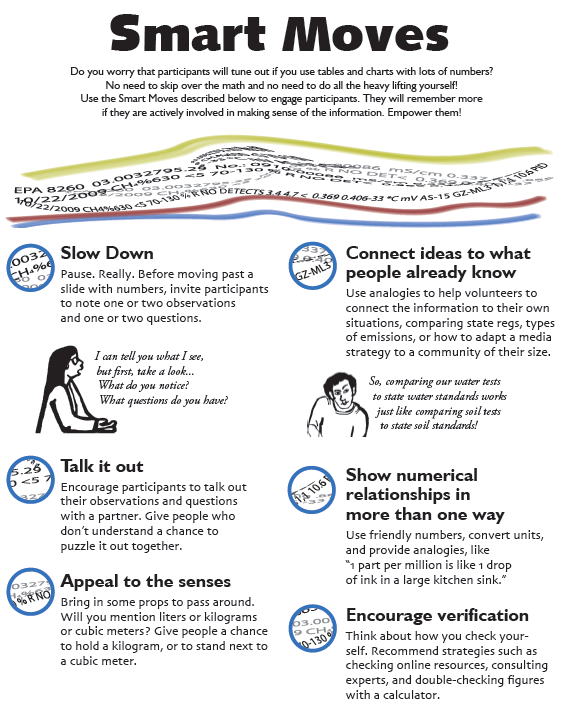Leading SfA Workshops
 No Technical Background Needed
No Technical Background Needed
No environmental science background is needed to lead Statistics for Action materials! Everyone in the room pools their knowledge to make sense of data. Watch our video tour, explore Using SfA, or browse all of our materials directly to get a sense for how SfA might fit your group or organization.
Facilitator Preparation
SfA resources are designed with six Smart Moves in mind. Before leading, ground yourself in these Smart Moves, and be ready to model them. When you delve into technical reports and data, the Smart Moves will help your group avoid feeling overwhelmed. If you're interested in learning about the educational theory behind SfA, read Current Perspectives on Adult Numeracy.
Tips from SfA Partners
Our partner organizations offer these tips for leading SfA activities:
- It's worth the extra time to use an interactive or hands-on activity! It sparks curiosity and is more memorable than an all-talk meeting or a PowerPoint presentation.
- Read through the activity thoroughly. Make sure you have the materials and data you need. If the data is in tiny print, try enlarging to bigger paper.
- Read through your data/scenario, and anticipate questions participants might have about terminology or context. Rehearse giving the directions out loud, so group members wll be clear on how to begin and what their goal is.
- Don't flood your group with hundreds of pages of data. Look through a report beforehand, by yourself. Choose a few typical tables or pages. Once people feel comfortable with one or two pages, they can do more.
- No matter prepared you are, looking at unfamiliar data and terms will still be very stressful for many people. This is why the Smart Moves are important. Slowing down, talking it out with a partner, and making analogies to connect to what people already know help reduce anxiety and make the task feel more manageable.
Train Your Staff
Want to train the staff of your own organization to lead SfA? Follow these steps. Each step represents a deepening level of staff training, and assumes you've done the previous step(s). These also assume you are already familiar with SfA.
- Overview: Show the SfA video tour to your staff. Then, hand out the SfA overview to your staff, review it with them (including any examples of current work for which they might be useful), and invite any questions. Give them a copy of an activity and a guide to read on their own (30-45 mins total.)
- Activity Run-Through: Try out a number of activities with your group. Choose activities most relevant for them, or use one of several workshops TERC staff have prepared for other organizations. Ideally, use a single community story or data set across all activities. For a smaller staff (4-5 people) do activities all together in sequence. For 6 or more people, do activities concurrently in pairs or small groups, and have the groups report back. (90-180 mins)
- "Scavenger Hunt": Present the group with one or more situations they might encounter in their work that involve environmental data or health. In small groups, have them hunt through the SfA overview for potentially useful activities and resources. They should find these activities on the SfA website and read through them. Each small group should report back describing their scenario, which activities or resources they chose, and how they would use them. (60 mins)
- Practice Facilitation: Have each person or pair plan and lead an SfA activity for the rest of the group, using community stories/data from your own organization's work. (Time depends on group size and activities chosen.)
Please contact us for more coaching on leading SfA or training others, or let us know what you used and how it went!
